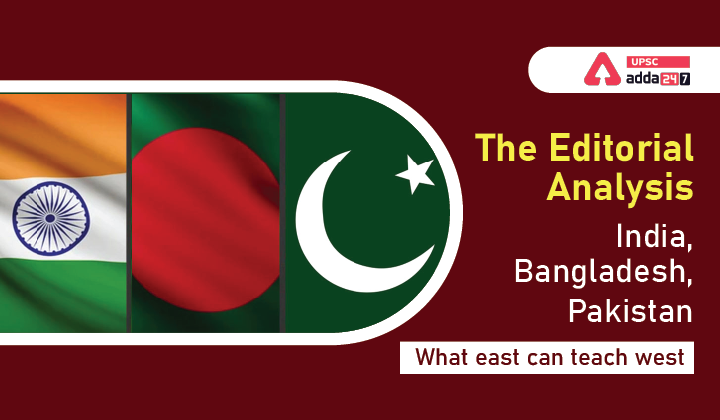Table of Contents
The Editorial Analysis- India, Bangladesh, Pakistan: What east can teach west- Relevance for UPSC
General Studies II- India and its neighborhood- relations.
India’s relations with Bangladesh and Pakistan
- The persistence of cross-border terrorism, the conflict over Kashmir, the militarization of the frontier, little connectivity, poor trade relations and no formal inter-governmental negotiations paint a bleak picture of the India-Pak border.
- The inability of successive generations of Indian and Pakistani leaders to bring a closure to Partition in the west makes the talk of a “100-year war” credible.
- The only trend that can counter this pessimism is the good news from India’s eastern frontier with Bangladesh.
- In contrast to the talk of a 100-year war between India and Pakistan, India and Bangladesh have proclaimed a “Sonali Adhyay” or “golden chapter” in bilateral relations.
- For both Delhi and Dhaka, the reinvention of the bilateral relationship has been one of the most significant successes of their recent foreign policies.
Building Relations
- The work on rebuilding ties began in earnest in 2010, when Sheikh Hasina came to India after taking charge of Bangladesh as prime minister for the second time in 2009.
- Both sides embarked on an extraordinary effort to address most bilateral problems—including border settlement, river water sharing, cross-border terrorism, market access to Bangladeshi goods, and connectivity.
- The land boundary deal got parliamentary approval in 2015 in India.
- India also accepted the award of the Permanent Court of Arbitration in The Hague on settling the maritime boundary dispute between Delhi and Dhaka.
- Cooperation on cross-border terrorism that began a couple of years earlier helped build much-needed political trust between the two national security establishments.
- Connectivity: On the connectivity front, we have seen a substantive movement towards reopening the border that was largely shut down after the 1965 war between India and Pakistan.
- Trans-boundary bus services, reopening of railway lines, and the revitalisation of waterways are restoring connectivity in the eastern subcontinent that was severed.
- Bilateral trade volumes have grown by leaps and bounds in recent years touching nearly $16 billion last year.
- Bangladesh is one of India’s top export markets.
- India and Bangladesh have also developed inter-connected power grids facilitating Dhaka’s purchase of power from India.
- It currently buys about 1200 MW of power from India and an additional 1500 MW is in the pipeline.
- The northeastern states have realised the immense benefits of deeper economic engagement with Bangladesh — none of them more important than ending the geographic isolation of the region.
- Assam today is at the forefront of imagining a bolder agenda for deepening economic ties with Bangladesh.
- For India, the expansive partnership with Bangladesh has significantly eased its security challenges and laid the basis for peace and prosperity in the eastern subcontinent.
- For Bangladesh, discarding the temptation to balance India and embark on a cooperative strategy has allowed Dhaka to focus on its economic growth and lift itself in the regional and global hierarchy.
What can be done?
- Rather than regret the unfortunate dynamic on the western frontier and bemoan Pakistan’s reluctance to let the SAARC become a vehicle for regional cooperation, Delhi should focus on consolidating the “golden moment” in the east.
- The issues such as protecting the rights of minorities, sharing the waters of more than 50 rivers, promoting cross-border investments, managing one of the longest borders in the world, facilitating trade and preventing illegal migration, countering forces of religious extremism, promoting maritime security in the Bay of Bengal, expanding defence cooperation, and mitigating climate change in the shared regional environment to name a few should be addressed jointly as well.
- Solving problems and tending to the relationship must necessarily be a continuous effort rather than episodic.




 TSPSC Group 1 Question Paper 2024, Downl...
TSPSC Group 1 Question Paper 2024, Downl...
 TSPSC Group 1 Answer key 2024 Out, Downl...
TSPSC Group 1 Answer key 2024 Out, Downl...
 UPSC Prelims 2024 Question Paper, Downlo...
UPSC Prelims 2024 Question Paper, Downlo...





